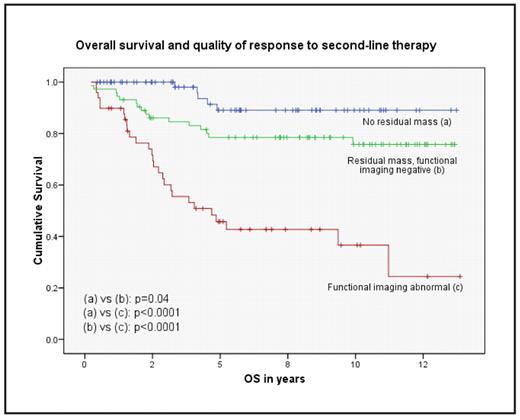Abstract
The standard treatment for relapsed and primary refractory (rel/ref) Hodgkin lymphoma (HL) for patients (pts) who demonstrate chemosensitivity to second-line chemotherapy (ST) is high dose chemotherapy followed by autologous stem cell transplantation (HDT-ASCT). Since 1994, four studies at our institution evaluated ICE (ifosfamide, carboplatin, and etoposide) based salvage therapy followed by HDT-ASCT in rel/ref HL. Chemosensitivity is a requirement for pts to proceed to HDT-ASCT, however the definition of chemosensitivity is broad. We use both functional imaging (gallium or PET) and CT to assess response to ICE; pts with chemosensitive disease fall into three groups: normalization of CT and FI (NRM), residual mass on CT but with negative FI (RM, FI-), and FI positivity regardless of CT finding (FI+). Here we report the outcome for pts who responded to ICE ST and proceeded to HDT-ASCT.
Between October 1994 and February 2008, 198 pts received ICE on 1 of 4 consecutive protocols (169 pts) or as per protocol (29 pts) and were deemed transplant-eligible. The median follow-up for surviving patients is 7.4 years. There were 99 male pts and 99 female pts; the median age was 31. With respect to the 3 pre-salvage chemotherapy risk factors (RF) (relapse within 1 year of primary treatment, presence of extranodal disease, and B symptoms): 44 pts had 0 RF, 64 had 1 RF, 75 had 2 RF, and 8 had 3 RF. Bulky disease defined as greater than 5cm or 10cm was present in 60 (30%) and 15 (7.5%) pts respectively.
The five year event free survival (EFS) and overall survival (OS) were 69% and 78% respectively. Seventy six (38%) had a NRM response to ST, 73 (37%) had a RM, FI- response, and 49 (25%) were FI+. The 5 year EFS and OS for the three groups were 86% and 93%, 71% and 79%, and 41% and 51% respectively. There was a statistically significant improvement in OS and EFS for the NRM and RM, FI- groups compared to the FI+ group (p<0.0001). Surprisingly, a comparison between the NRM and RM, FI- groups also revealed a statistically significant improvement in EFS and OS for the NRM group (p=0.05 and 0.04 respectively).
Response to ICE ST followed by HDT-ASCT is associated with a prolonged EFS and OS. The quality of response to ICE ST had a significant impact on outcome. Both a residual mass with normalized FI and abnormal FI after ST predicts for an inferior outcome following HDT-ASCT. However, residual radiotracer on FI was associated with the poorest outcome in both EFS and OS.
CONCLUSION: Outcome cannot be predicted by FI alone since both RM, FI- and FI+ groups had an inferior outcome compared to NRM. The most accurate post treatment evaluation includes both CT and PET.
Disclosures: No relevant conflicts of interest to declare.
Author notes
Corresponding author


This feature is available to Subscribers Only
Sign In or Create an Account Close Modal